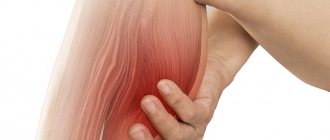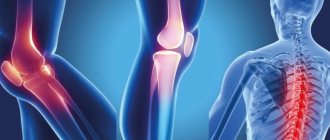Composition and release form
Mydocalm® Film-coated tablets - 1 tablet.
tolperisone (in the form of hydrochloride) - 50 mg - 150 mg excipients: citric acid monohydrate; colloidal silicone anhydrous; stearin; talc; MCC; corn starch; lactose monohydrate; titanium dioxide; macrogol 6000; hydroxypropyl methylcellulose 2910 in blister 10 pcs.; There are 3 blisters in a box. Mydocalm®-Richter Solution for injection - 1 amp. (1 ml) tolperisone (in the form of hydrochloride) - 100 mg lidocaine (in the form of hydrochloride) - 2.5 mg excipients: methylparaben; diethylene glycol monoethyl ether; water for injection in dark glass ampoules of 1 ml; There are 5 ampoules in a box.
Mydocalm - a medicine for back and muscle pain
Pain is not the most pleasant thing the body can give us. Especially if it is strong, and, even worse, permanent. In such cases, the attending physician may prescribe the muscle relaxant Mydocalm, which helps relieve tension and pain.
The doctor prescribes Mydocalm for back and muscle pain
The drug helps relax skeletal muscles as a result of neurological syndromes, which in turn are associated with pain and impaired trophism (the process of cellular nutrition of organs and tissues); reduction of hypertonicity and spasticity; has a local anesthetic effect.
Indications for use
Mydocalm is prescribed in the following cases:
- pathologically increased muscle tone and spasms of skeletal (striated) muscle tissue, which are a consequence of organic lesions of the central nervous system, including multiple sclerosis, encephalomyelitis, cerebral stroke, etc.;
- myogenic contractures, increased muscle tone and spasticity caused by diseases of the musculoskeletal system (for example, lumbago with sciatica, spondylosis, arthrosis affecting large joints, cervical syndrome, etc.);
- non-inflammatory diseases of the brain, accompanied by disorders of muscle tone;
- cholelithiasis;
- severe pain syndrome, observed against the background of the development of hemorrhoids;
- menstrual pain syndrome;
- the threat of spontaneous abortion due to increased tone of the uterine muscle structures;
- renal colic;
- during the period of rehabilitation therapy after orthopedic, surgical or traumatological operations;
- as part of complex therapy for obliterating vascular diseases (arteriosclerosis, diabetic angiopathy, thromboangiitis, Raynaud's disease, diffuse scleroderma);
- pathologies caused by disorders of vascular innervation (acrocyanosis, intermittent angioedema);
- Little's disease (cerebral spastic palsy) and other encephalopathies accompanied by muscular dystonia;
- diseases occurring with muscular dystonia;
- osteochondrosis.
Contraindications
Contraindications to the use of Mydocalm tablets:
- age up to one year;
- persistent pathological weakness and rapid fatigue of skeletal muscle tissue (myasthenia gravis);
- increased individual sensitivity to the active substance and auxiliary components of the drug.
All muscle relaxants are contraindicated in patients:
- currently or with a history of increased seizure activity;
- those suffering from Parkinson's disease;
- suffering from chronic renal and/or liver failure;
- suffering from epileptic seizures;
- having a history of drug addiction;
- with a history of acute psychosis.
Side effects of the drug Mydocalm
Taking the medicine Mydocalm can provoke the appearance of adverse reactions from various organs and systems.
One of the side effects of Mydocalm is insomnia.
Infrequent (occur no more than once in a thousand cases) reactions that may occur after taking Mydocalm include:
- eating and metabolic disorders, which are expressed in the form of anorexia;
- insomnia and sleep disorders;
- headache, dizziness, increased drowsiness;
- arterial hypotension;
- feeling of discomfort in the abdomen, diarrhea, increased dryness of the mucous membrane in the mouth, dyspeptic symptoms, nausea;
- muscle weakness, pain in the limbs, muscle pain;
- asthenia, feeling of general discomfort, increased fatigue.
Rare (occur more than once in a thousand cases, but less than once in ten thousand cases) include:
- anaphylactic reaction;
- decreased activity, depressive states;
- disturbances of attention, tremor, increased convulsive activity, hypoesthesia (decreased sensitivity to the effects of stimuli), paresthesia, increased drowsiness;
- tinnitus, vertigo;
- angina pectoris, tachycardia, rapid heartbeat, decreased blood pressure;
- hyperemia of the skin;
- difficulty breathing, nosebleeds, rapid breathing;
- pain in the epigastric region, constipation, flatulence, vomiting;
- mild forms of liver dysfunction;
- allergic dermatitis, increased sweating, itching, urticaria, skin rashes;
- feeling of discomfort in the limbs;
- enuresis, proteinuria;
- feeling of intoxication, feeling of heat, irritability, increased thirst;
- increased bilirubin levels in the blood, changes in the activity of liver enzymes, decreased platelet levels, leukocytosis.
Extremely rare (occur no more often than in one in ten thousand cases) include:
- anemia, enlarged lymph nodes (lymphadenopathy);
- anaphylaxis (anaphylactic shock);
- polydipsia;
- confusion;
- bradycardia;
- osteopenia;
- feeling of discomfort in the chest;
- increase in creatinine level in the blood.
If the patient experiences side effects, the dose of the drug is reduced, after which the reactions described above are usually leveled out.
How to take Mydocalm?
The dosage and period of taking the drug are calculated by the doctor based on medical history, muscle tone, intensity of pain, the presence of contraindications in the patient and concomitant chronic diseases.
Usually the duration of treatment does not exceed ten days. After administration, Mydocalm begins to act approximately 40 minutes later. The effect lasts from 4 to 6 hours.
Mydocalm is available in two dosage forms:
- tablets 50 mg and 150 mg;
- solution for injection in ampoules of 1 ml.
Mydocalm is taken orally, strictly after meals, with a small amount of water. To avoid complications and side effects, you should strictly follow the dosage prescribed by your doctor.
The average therapeutic dosage of the drug depends on the age of the patient. Doses of the drug (tablets):
- adults and children over 14 years of age: 50 mg 2-3 times a day, gradually increasing the dose to 150 mg;
- children aged 7-14 years: daily dose at the rate of 2-4 mg/kg (in 3 divided doses during the day);
- children aged 3 to 6 years: daily dose at the rate of 5 mg/kg (in 3 divided doses during the day).
Doses of the drug (injections):
- intramuscularly – 200 mg per day, divided into two doses;
- The drug is administered intravenously slowly, by drip, 1 ml once a day.
Mydocalm during pregnancy and lactation
Like any medicine, Mydocalm is prescribed with caution to pregnant women and mothers who are breastfeeding. This occurs only when the expected benefit to the mother outweighs the risks to the fetus or newborn. Experts recommend transferring the baby from breastfeeding to artificial feeding while taking the drug.
Mydocalm during pregnancy
However, Mydocalm can be prescribed to women in the first trimester of pregnancy if there is a threat of miscarriage.
Mydocalm for osteochondrosis
Like other centrally acting muscle relaxants, Mydocalm can be prescribed for osteochondrosis. The pain syndrome, which is inevitable with this disease, entails limited mobility. This is where muscle relaxants, in particular Mydocalm, come to the rescue.
A drug:
- relieve pain symptoms;
- suppresses spinal reflexes;
- relieves muscle tension.
Due to these qualities, muscle relaxants are included in the therapeutic course along with massage, exercise therapy, etc. Moreover, it is worth noting that, unlike chondroprotectors, they actually improve the condition of patients suffering from osteochondrosis.
Mydocalm is prescribed for osteochondrosis
For the treatment of osteochondrosis, Mydocalm, like other muscle relaxants, is prescribed in short courses.
Interaction
Studies have shown that medications that would limit the use of Mydocalm have not been identified. Since the active substance of Mydocalm - tolperisone - does not provoke a sedative effect, it can be combined with drugs that have a sedative effect, as well as sleeping pills and drugs containing alcohol.
The activity of the substance is enhanced by:
- preparations for general anesthesia;
- peripherally acting muscle relaxants;
- psychotropic drugs;
- clonidine (a substance that has a hypotensive effect).
Doctors often prescribe to patients with pathologies of the musculoskeletal system a combination of the drugs Milgamma, Movalis and Mydocalm as a complex therapy.
Thus, Mydocalm and Movalis relieve pain, spasms and muscle hypertonicity. And the drug Milgamma, which belongs to the B vitamins, is used as a general tonic with metabolic, analgesic and neuroprotective effects.
The combination of Mydocalm and alcohol is acceptable. But in any case, you shouldn’t get carried away, since Mydocalm is a medicine.
The regimen for simultaneous use of several drugs is determined by the attending physician.
Analogues of Mydocalm
Often analogues are selected by a doctor if the patient is intolerant of the active substance or components of the drug, due to contraindications or even price.
Analogues of Mydocalm
Analogues of the drug:
- Sirdalud (active ingredient: tizanidine) - Mydocalm has a wider spectrum of action, but Sirdalud is characterized by fewer side effects;
- Miolgin (active ingredients: paracetamol and chlorzoxazone) - indications for use and scheme of action are similar to Mydocalm. Additionally, it has an antipyretic effect;
- Tolperisone-OBL (active ingredient: tolperisone) - the active component, indications, contraindications and scheme of action are identical. Tolperisone is characterized by its low cost;
- Baclofen (active ingredient: baclofen) - the effectiveness of the drugs is similar, but Baclofen has a rather impressive list of side effects.
Analogs have a similar effect on the body, but changing Mydocalm to another, similar medication is possible after consultation and permission from the attending physician.
Sources
- Kamchatnov P.R., Umarova H.Ya., Chugunov A.V., Kazakov A.Yu. // Neuromuscular diseases. — 201 z. -No. 3. — P.32-37.
- Kovalchuk V.V., Skoromets A.A., Vasilyeva I.V. // Journal. neurology and psychiatry named after. S.S. Korsakov. - 2008. - No. 8. — P.14-19.
- Kremis V.M. // Kubansk. scientific honey. messenger -2009. - No. 3 (180). — P.63-66.
- Pretzel HG, Aiken RG, Ramm s. Pain 67.41?, 1996.; 2. Gurak S.V., Parfenov B.A., Borisov K.V. Pain, Daz (12) 2006; 3. Dultn J., Kovacs L., Ramm S. et al. Pharmacopsychlatr., 1998,31,137-142;
- Bakheit AM, Thilmann AF, Ward AB et al. A randomized, double-blind, placebo-controlled, dose-ranging study to compare the efficacy and safety of three doses of botulinum toxin type A (Dysport) with placebo in upper limb spasticity after stroke. Stroke 2000;31:2402—b.
Mydocalm-Richter, 100 mg+2.5 mg/ml, solution for injection, 1 ml, 5 pcs.
Gedeon Richter, Hungary
Price from 463₽
Mydocalm, 50 mg, film-coated tablets, 30 pcs.
Gedeon Richter, Russia
Price from 326₽
There are contraindications. Specialist consultation is required.
Indications for use of Mydocalm
Mydocalm should be taken for spinal and cerebral palsy with increased tone, spasms, spinal automatism, for contractures of the limbs, for diseases with dystonia, rigidity, spasms, obliterating vascular diseases: obliterating atherosclerosis of the vessels of the extremities, diabetic angiopathy, thromboangiitis obliterans, Raynaud's syndrome, consequences of disorders vascular innervation (acrocyanosis, intermittent angioedema), postthrombotic disorders of lymph circulation and venous circulation, trophic ulcer of the leg, spastic paralysis, encephalopathy, a combination of hypertonicity with a violation of muscle tone of another type.
Contraindications
Contraindications to the use of Mydocalm-Richter are:
- hypersensitivity to any of the active or auxiliary substances included in the drug (including lidocaine and other amide drugs that have a local anesthetic effect);
- myasthenia gravis in severe form;
- pregnancy;
- lactation.
The drug also has age restrictions: injections of the drug are contraindicated for persons under 18 years of age.
Note!
Description of the drug Mydocalm solution d/in. amp. 1ml No. 5 on this page is a simplified author’s version of the apteka911 website, created on the basis of the instructions for use.
Before purchasing or using the drug, you should consult your doctor and read the manufacturer's original instructions (attached to each package of the drug). Information about the drug is provided for informational purposes only and should not be used as a guide to self-medication. Only a doctor can decide to prescribe the drug, as well as determine the dose and methods of its use.
special instructions
The injection form of the drug is not prescribed to children!
Hypersensitivity reactions. In the post-marketing period, hypersensitivity reactions were most often observed with the use of tolperisone. Their severity varies from mild skin reactions to severe systemic reactions, including anaphylactic shock. Symptoms of hypersensitivity reactions may include erythema, rash, urticaria, pruritus, angioedema, tachycardia, hypotension, or shortness of breath.
Women with a history of hypersensitivity to other drugs or allergic conditions are at higher risk of hypersensitivity reactions when taking tolperisone.
Patients should be advised to closely monitor their condition to identify possible allergy symptoms. Patients should be advised that if allergy symptoms occur, stop taking tolperisone and seek immediate medical attention.
After an episode of hypersensitivity to tolperisone, the drug cannot be re-prescribed.
The drug in tablet form contains lactose monohydrate. If you are lactose intolerant, Lapp lactase deficiency or glucose-galactose malabsorption, you should not use this medicine.
The drug in the form of a solution contains lidocaine, therefore, in case of known hypersensitivity to lidocaine and other amide local anesthetics, Mydocalm for injection should not be used due to the possibility of developing cross-allergic reactions.
Use during pregnancy and lactation. According to animal studies, tolperisone does not have a teratogenic effect.
Due to the lack of significant clinical data on the use of this drug, Mydocalm should not be used during pregnancy.
Since it is unknown whether tolperisone passes into breast milk, the use of Mydocalm during breastfeeding is contraindicated.
Children. Mydocalm injection solution is not used in children. The safety and effectiveness of the drug in tablet form in children have not been studied.
The ability to influence reaction speed when driving vehicles and working with other mechanisms. Considering the possibility of developing symptoms such as dizziness, drowsiness, impaired attention, epilepsy, blurred vision, the drug should be used with caution when driving or operating other mechanisms.
Pharmacological properties
Pharmacodynamics.
tolperisone is a centrally acting muscle relaxant. The mechanism of action of tolperisone is not fully understood. It has high affinity for nervous tissue, reaching highest concentrations in the brainstem, spinal cord and peripheral nervous system.
The most significant effect of tolperisone is its inhibitory effect on the spinal reflex pathway. It is likely that this effect, combined with the inhibitory effect on descending pathways, determines the therapeutic effect of tolperisone.
The chemical structure of tolperisone is similar to that of lidocaine. Like lidocaine, it has a membrane-stabilizing effect and reduces the electrical excitability of motor neurons and primary afferent fibers. Tolperisone dose-dependently inhibits the activity of voltage-gated sodium channels. Accordingly, the amplitude and frequency of the action potential decreases.
A proven inhibitory effect on voltage-gated calcium channels. This indicates that tolperisone not only has a membrane-stabilizing effect, but can also suppress the release of transmitters.
To top it all off, tolperisone has weak α-adrenergic receptor antagonist properties and has an antimuscarinic effect.
Clinical efficacy and safety. Tolperisone has been proven effective in treating muscle spasms after a stroke.
In a randomized, double-blind, placebo-controlled study of 120 patients with muscle spasm after stroke, treatment with tolperisone showed a highly significant reduction in Ashworth spasticity, the primary outcome measure. Tolperisone was superior to placebo according to physician and investigator overall efficacy ratings (p0.001). The mean improvement in the Ashworth score was 32% in the overall intention-to-treat (ITT) population and 42% in the subgroup of patients receiving tolperisone 300–450 mg/day. When assessing the performance of functional tests, the effectiveness of tolperisone was also higher than the effectiveness of placebo, but the differences were statistically insignificant.
In a randomized, double-blind comparative study involving 48 patients with brain damage, the efficacy of tolperisone according to the Barthel index was comparable to that of baclofen. However, tolperisone was superior to baclofen in improving the Rivermead Motor Assessment Scale (RMAS).
Data on the effectiveness of tolperisone for increased muscle tone in patients with musculoskeletal diseases other than muscle spasm after stroke are contradictory. Some studies have reported positive results on some tests, while other studies have found no benefit of tolperisone in these conditions.
The safety profile of tolperisone is based on data from clinical studies involving patients with increased muscle tone of various etiologies, as well as on data from spontaneous reports of adverse reactions.
Pharmacokinetics. After oral administration, tolperisone is well absorbed in the small intestine. Cmax in blood plasma is achieved 0.5–1.5 hours after administration. Due to the significantly pronounced first-pass metabolism, the bioavailability of tolperisone is about 20%. Fatty foods increase the bioavailability of the drug after oral administration by approximately 100%, and Cmax in blood plasma by approximately 45% compared to administration on an empty stomach. The time to reach Cmax increases by approximately 30 minutes.
Tolperisone is extensively metabolized by the liver and kidneys. The drug is almost completely excreted by the kidneys (99%) in the form of metabolites. The pharmacological activity of the metabolites is unknown.
T½ of tolperisone after intravenous administration is about 1.5 hours, after oral administration - about 2.5 hours.
Preclinical safety data. Based on data from preclinical studies studying pharmacological safety, repeated use toxicity, genotoxicity, and toxic effects on reproductive function, no specific risk for humans was noted.
Effects in preclinical studies were detected only when taken in doses significantly higher than the maximum permissible dose for humans, which indicates little relevance for clinical use.
In rats and rabbits, embryotoxic changes were detected upon oral administration of the drug in doses of 500 mg/kg body weight and 250 mg/kg body weight, respectively. However, these doses are many times higher than the recommended therapeutic doses for humans.
Overdose
Data on cases of overdose with Mydocalm are limited. The drug is characterized by a wide therapeutic index.
According to preclinical studies of the acute toxicity of the solution, when the drug is administered in doses significantly higher than therapeutic, symptoms such as:
- disorders of the coordination of movements of various muscles in the absence of muscle weakness in the patient (ataxia);
- tonic-clonic seizures;
- difficulty breathing (up to its complete stop).
There is no specific antidote for tolperisone. If the recommended dose is exceeded, it is recommended that the patient undergo gastric lavage. The following are symptomatic and supportive therapies.
Reviews about Mydocalm-Richter
The drug is successfully used to treat patients in many countries around the world. It is well tolerated and does not have a sedative effect, which is confirmed by numerous randomized studies in which placebo was used.
Reviews of Mydocalm-Richter injections left by patients are overwhelmingly positive. The drug is described as an effective and affordable medicine. Only rarely can you find negative reviews that state the ineffectiveness of treatment with Mydocalm injections.
Some people note that the greatest effectiveness in the treatment of certain diseases (in particular, osteochondrosis ) was achieved using Mydocalm in combination with other medications.
Doctors confirm this opinion and often prescribe Mydocalm injections in combination with vitamin preparations with a general strengthening effect (for example, Milgamma or Kombilipen ) and non-steroidal anti-inflammatory drugs (for example, Movalis ).
Analogues Mydocalm-Richter
Level 4 ATC code matches:
Tizanil
Tizanidine
Tolperisone-OBL
Tizalud
Mydocalm
Baklosan
Sirdalud
Baclofen
Analogs of Mydocalm-Richter injections are medicines that have a muscle relaxant effect on the body, but contain substances different from the active components of Mydocalm. These include:
- Calmirex
- Lidamitol
- Myorizon
- Tolmio
- Tolsitol
- Baclofen
- Lioresal Intrathecal
- Mefedol
Interaction
There is no data on the compatibility study of Mydocalm, therefore, before administration, the solution should not be mixed in the same syringe with other drugs. The drug is administered separately from other drugs.
Despite the fact that Mydocalm-Richter is characterized by the ability to influence the central nervous system, there is no likelihood of developing a sedative effect when using it. It is allowed to prescribe the drug in combination with sedatives, sleeping pills, as well as drugs that contain alcohol.
Does not affect the effect of alcohol on the central nervous system.
If it is necessary to prescribe Mydocalm-Richter in combination with other centrally acting muscle relaxants, consider reducing the daily dose of tolperisone.
Tolperisone potentiates the pharmacological effect of niflumic acid and other non-steroidal anti-inflammatory drugs, which is why it is recommended to reduce the dose of the latter when taken simultaneously with tolperisone.
The pharmacological effects of tolperisone are enhanced by the following drugs:
- general anesthesia;
- peripherally acting muscle relaxants;
- psychotropic drugs;
- clonidine.











